Of course Maker Faire was loaded up with 3D printers, but we’re no longer in the era of a 3D printer in every single booth. Filament-based printers are passé, but that doesn’t mean there’s no new technology to demonstrate. This year, it was stereolithography and other resin-based printers. Here’s the roundup of each and every one displayed at the faire, and the reason it’s still not prime time for resin-based printers.
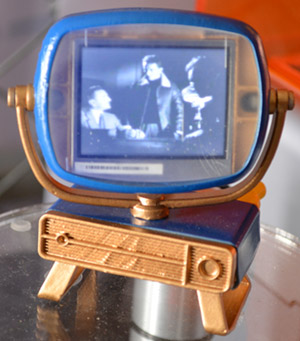 Formlabs
Formlabs
Of course the Formlabs Form 1+ was presented at the Bay Area Maker Faire. They were one of the first SLA printers on the market, and they’ve jumped through enough legal hoops to be able to call themselves the current kings of low-cost laser and resin printing. There were a few new companies and products at the Faire vying for the top spot, and this is where things get interesting.
The folks at Formlabs displayed the only functional print of all the resin-based 3D printing companies – a tiny, tiny Philco Predicta stuffed with an LCD displaying composite video. The display is covered by a 3D printed lens/window. That’s the closest you’re going to get to an optically clear 3D printed part at the Faire.
XYZPrinting Nobel
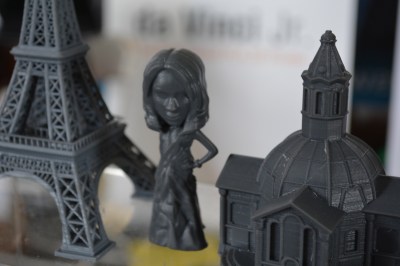
XYZPrinting, the company famous for the $500 printer that follows the Gillette model: sell the printer cheap, sell expensive replacement filament cartridges, and laugh all the way to the bank. Resetting the DRM on the XYZPrinting Da Vinci printer is easy, the proprietary host software is done away with, and bricked devices are not. Time for a new market, huh?
Enter the XYZPrinting Nobel, a resin printer that uses lasers to solidify parts 25 microns at a time. The build volume is 125x125x200mm (5x5x7.9″), with an X and Y resolution of 300 microns. Everything prints out just as you would expect. As far as laser resin printers go, it’s incredibly cheap: $1500. It does, however, use XYZware, the proprietary toolchain forced upon Da Vinci users, although the Nobel is a stand-alone printer that can pull a .STL file from a USB drive and turn it into an object without a computer. There was no mention of how – or if – this printer is locked down.
DWS Lab XFAB
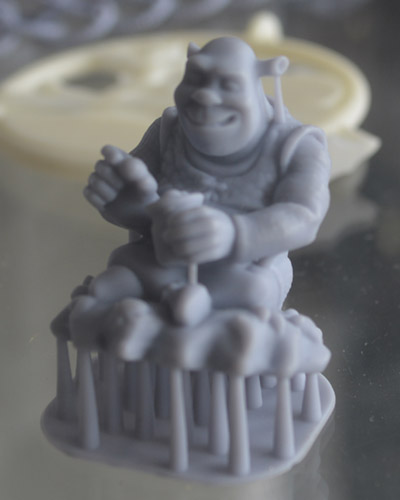
You’ve seen the cheapest, now check out the most expensive. It’s the DWS Lab XFAB, an enormous and impressive machine that has incredible resolution, a huge build area, and when you take into account other resin printers, a price approaching insanity.
First, the price: $5000 officially, although I heard rumors of $6500 around the 3D printing tent. No, it’s not for sale yet – they’re still in beta testing. Compare that to the Formlabs Form 1+ at $3300, or the XYZPrinting Nobel at $1500, and you would expect this printer to be incredible. You would be right.
The minimum feature size of the XFAB is 80 microns, and can slice down to 10 microns. Compare that to the 300 micron feature size of the Form 1+ and Nobel, and even on paper, you can tell they really have something here. Looking at the sample prints, they do. These are simply the highest resolution 3D printed objects I’ve ever seen. The quality of the prints compares to the finest resin cast objects, machined plastic, or any other manufacturing process. If you’re looking for a printer for very, very high quality work, this is what you need.
Sharebot Voyager
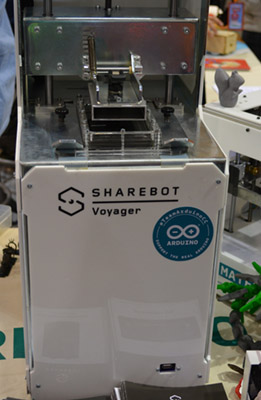 Also on display – but not in the 3D printing booth, for some reason – was the Sharebot Voyager. Unlike all the printers described above, this is a DLP printer; instead of lasers and galvos, the Voyager uses an off-the-shelf 3D DLP projector to harden layers of resin.
Also on display – but not in the 3D printing booth, for some reason – was the Sharebot Voyager. Unlike all the printers described above, this is a DLP printer; instead of lasers and galvos, the Voyager uses an off-the-shelf 3D DLP projector to harden layers of resin.
Strangely, the Sharebot Voyager was stuck in either the Atmel or the Arduino.cc (the [Massimo] one) booth. The printing area is a bit small – 56x96x100mm, but the resolution – on paper, mind you – goes beyond what the most expensive laser and galvo printers can manage: 50 microns in the X and Y axes, 20 to 100 microns in the Z. Compare that figure to the XFAB’s 80 micron minimum feature size, and you begin to see the genius of using a DLP projector.
The Sharebot Voyager is fully controllable over the web thanks to a 1.5GHz quad core, 1GB RAM computer that I believe is running 32 bit Windows. Yes, the spec sheet said OS: 32 bit Windows.
There were no sample prints, no price, and no expected release date. It is, for all intents and purposes, vaporware. I’ve seen it, I’ve taken pictures of it, but I’ve done that for a lot of products that never made it to market.
The Problem With Resin Printers
Taking a gander over all the resin-based 3D printers, you start to pick up on a few common themes. All the software is proprietary, and there is no open source solution for either moving galvos, lasers, or displaying images on a DLP projector correctly to run a resin-based machine. Yes, you heard it here first: it’s the first time in history Open Source hardware folk are ahead of the Open Source software folk. Honestly, open source resin printer hosts is something that should have been done years ago.
This will change in just a few months. A scary, tattooed little bird told me there will soon be an open source solution to printing in resin by the Detroit Maker Faire. Then, finally, the deluge of resin.

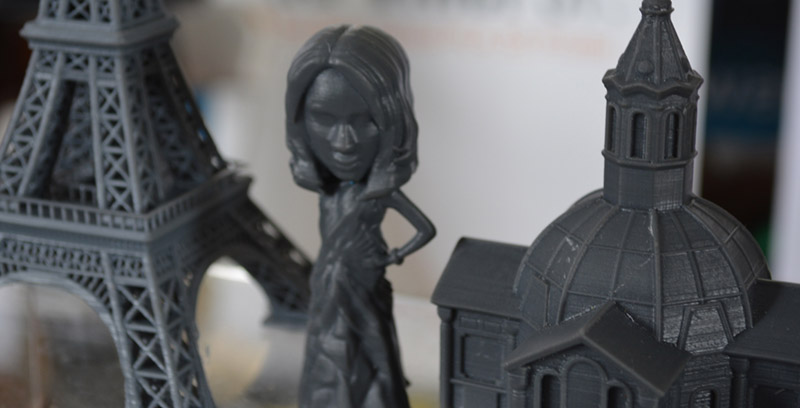















I had a chance to talk to the guys at the Sharebot Voyager table. They were expecting a price of $7k, with a print speed of something around 3cm per HOUR. I was curious about the tiny print platform, and their answer came down to a larger print bed requiring lower resolution as a result. Hopefully they will find a way to overlap multiple DLP projectors or similar, to get a bigger working surface.
Well, I guess you got a finite number of pixels the project does – lets say 1080p and you can scale that sort of however you like.
So to have bigger build volumes at the high res you could (somehow) use multiple projectors….or maybe one projector and some sort of mirror system that moves the projection about? (so it solidifies one high res square at a time).
Youd lose speed of course.
I thought “lemon curry” was the open source DLP resin printer?
I’m still waiting for a kickstarter FSL3D “pegasus touch”, long after all units were supposably shipped. Kickstarter finished in Jan 2014 with ETA August for my tier level.
In fairness it’s spared me the trials and tribulations of quickly-clouding build trays that are barely resurfacable, propriatry software which costs ~US$300 to “transfer the license” of the unit if you sell it, the unit itself running a suspiciously *nix-like environment without any source, and of course propriatary resin that costs slightly more than molten plutonium, while being harder to get (Specifically US$100/litre in bulk plus shipping).
On my side I have asked for the unit to be shipped (extra international shipping was paid in 2014), refunded (if all units are shipper, material costs for special orders are irrelevant) or the case escalated to management and awaiting further response. I’m not holding my breath.
3D printing has LAYERS.
<>
this is wrong!
I developed one myself 3 years ago:
http://forum.allinbox.com/aspectgeek/Montages-Mecaniques-Electroniques/3D-print/3dprint-logiciel-slicer-sujet_15_1.htm
you can see here some object printed with it:
http://forum.allinbox.com/aspectgeek/Montages-Mecaniques-Electroniques/3D-print/real-3dprint-v2-sujet_126_1.htm
http://forum.allinbox.com/aspectgeek/Montages-Mecaniques-Electroniques/3D-print/real-print-version-sujet_93_1.htm
and another one is in development by another member of the group:
http://forum.allinbox.com/aspectgeek/Montages-Mecaniques-Electroniques/3D-print/real-3dprint-v3-sujet_127_1.htm
http://forum.allinbox.com/aspectgeek/Montages-Mecaniques-Electroniques/3D-print/3dprint-nouveau-slicer-sujet_131_1.htm
ho, i forgoted, there is a github repository: https://github.com/3dsman/openDlpSlicer
I thought pronterface had a resin printer mode for projectors. Also, doesn’t seem like it would be difficult to fake a laser as a hotend with the current os software available.
The bulk of us reprap guys are running Creation Workshop for our DLP printers: http://www.envisionlabs.net/
What about a large build volume *and* a high resolution photopolymer resin?
What about the open source resin printers at http://www.littlerp.com/ or http://sedgwick3d.com/ ?
The Sedgwick resin printer has been around for years http://hackaday.com/2012/07/05/3d-dlp-printer-builds-an-orange-tardis/
Ditto about Creation Workshop.
I personally have the LittleRP and really like it: https://www.flickr.com/photos/sbgraber/sets/72157646741724310
Bah! This is far more versatile, and a little less expensive. http://www.amazon.com/Yasutomo-Niji-Woodcarving-Set-set/dp/B0027AGN6Q/
And the Muve 3D is open source also and uses Creation Workshop too! (I love mine!)
Open source SLS printer
Peachy printer Cost $100 (kit) (still in development)
Maker Juice $55/litre – bulk buy $33/litre (for sale right now)
theoretical z resolution 1/1000th of an inch (ye they are still working on getting that..)
could well be another year before they have a stable product but right now it is an SLS printer printing objects smooth to the touch
https://www.kickstarter.com/projects/117421627/the-peachy-printer-the-first-100-3d-printer-and-sc
“and there is no open source solution for either moving galvos, lasers”
Here is open source hardware and firmware to drive lasers and galvos:
http://macpod.net/electronics/lasershark/lasershark.php
Creation Workshop works with it. There is also the start of this:
https://github.com/macpod/lasershark_3dp
Reading further into this perhaps the author was suggesting greater at the lack of a host app to run this? This is a little more understandable.
I ran into this article via search results concerning looking for any new resins that may be available. I like how the readers responded with numerous open source options. I too use Creation Workshop. A lot of the commercial DLP based SLA 3D printers use custom branded versions of Creation Workshop as well.
Resin printers are gaining in popularity, but not as fast as I thought they would. I expected around five times the activity now as compared to 2 years ago. I think this is mainly due to the expense of projectors / galvos and the mUVe 3D version that uses an ordinary Cartesian coordinate system to move a laser is simply not know of very well.